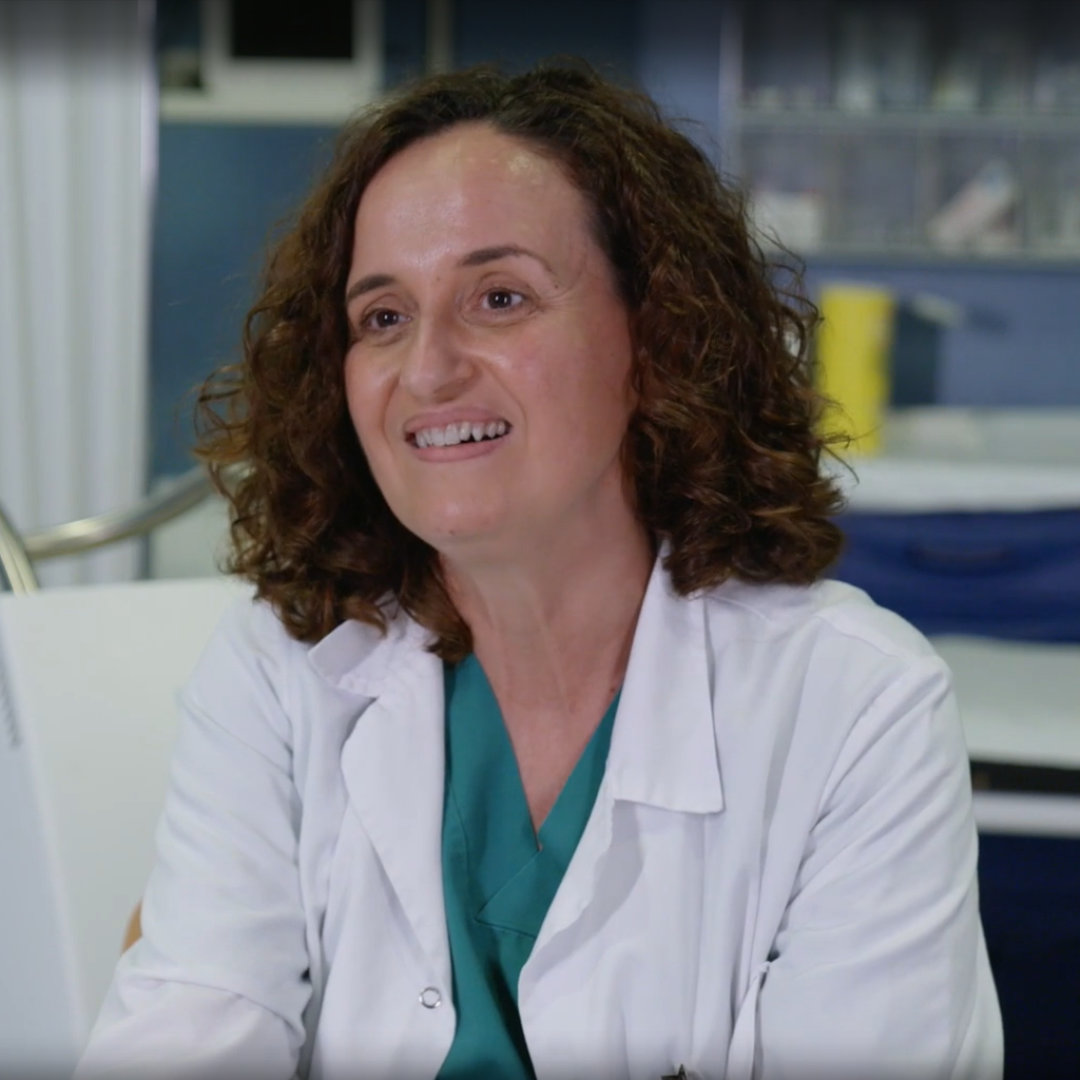
Clinical Oncology Nurses
Healthcare Perspective
Nurse Esther
Esther is a specialized radiation oncologist nurse working with the brachytherapy and radiotherapy teams at Fundacion Instituto Valenciano de Oncologia in Spain. In this video, she talks about how these teams of professionals approach patient care and how genuine and ongoing communication with patients helps alleviate their stress during the brachytherapy procedure.

Brachytherapy Support
Brachytherapy is a type of internal radiation therapy used to treat cancer. Brachytherapy involves placing a radioactive source directly inside or next to the tumor to target the cancer cells. This technique allows for a high dose of radiation to be delivered to the tumor while sparing the healthy surrounding tissue. The brachytherapy radioactive seeds are about the size of a grain of rice.
Brachytherapy has been used successfully to treat a variety of cancers, including prostate cancer, breast cancer, and cervical cancer. The technique is highly effective, with a lower risk of side effects than traditional radiation therapy, making it a popular treatment option, especially as it reduces radioactive material exposure to healthy tissue. There are two types of brachytherapy - high dose rate brachytherapy and low dose rate brachytherapy. The type of cancer you have and the severity of the cancer will determine if you have high dose rate brachytherapy or low dose rate brachytherapy.
After your imaging tests and diagnosis, you face your treatment. But, going through brachytherapy procedures can still be overwhelming. Having a treatment team who will support you during and after cancer treatment is an important part of the healing process.
As a radiation oncology nurse, Esther describes how she collaborates every day with the brachytherapy treatment team to deliver safe and effective care to her patients. She explains the importance of teamwork to provide comprehensive care to treat cancers in a compassionate way, where the patient’s physical and emotional health needs are considered.
Esther works closely with the extended medical team to ensure that each patient receives the best possible care while treating cancer. The collaboration happens long before the day of brachytherapy. She participates in daily meetings where the team discusses cancer patients' cases, and defines the appropriate treatment plan. She is then responsible for organizing the details of the brachytherapy procedure. She will provide ongoing care, and ensure the patient's comfort and safety throughout the cancer treatments which occur over a few weeks.
Radiation oncologists like Esther are uniquely positioned to support their patients throughout the brachytherapy process. They are here to treat cancer but also emotionally accompany their patients as they navigate one of the scariest moments of their lives.
Roles of A Radiation Oncology Nurse
Nurses like Esther play a crucial role in the care of cancer patients receiving radiation therapy. They work closely with radiation oncologists and other healthcare professionals to develop individualized treatment plans and provide emotional support throughout the treatment process. Nurses educate patients about the potential side effects of radiation therapy, monitor them for adverse reactions, and manage symptoms to improve their quality of life. They also work to ensure the safety of everyone during radiation treatments. Overall, these nurses are essential members of the cancer care team, providing compassionate and skilled care to patients undergoing radiation therapy.
Patient Education
Before they begin brachytherapy, the nursing team talk a lot with their patients to create a respectful and trustworthy environment, thus relieving some stress. Esther and her team are responsible for educating each person about their diagnosis, whether it be skin cancer, prostate cancer, cervical cancer or another type of cancer, the health care team are there to educate and guide patients through the difficult news. They must also discuss the brachytherapy procedure and what it involves. Esther and her team are always there to answer pressing questions.
Treatment Session
On the morning of the treatment session, Esther takes care of all administrative tasks and treatment details in order to minimize the waiting time. This includes things such as calculating the required dose of internal radiation, as it can be a high dose rate or low dose rate.
During therapy, she coordinates care, administers the required treatment, and addresses the physical needs of her patients. Esther also plays an essential role in her patients' emotional well-being. She ensures that they are comfortable, less anxious, and feel safe throughout the continuum of care.

Emotional Support
Most people are nervous and worried when entering the brachytherapy suite. Some are still unfamiliar with internal radiotherapy and have a lot of questions. Most of them are at the end of an exhausting radiation treatment protocol after receiving external beam radiotherapy, chemotherapy or other radiation treatments. Oncology nurses often spend significant amounts of time with patients, answering questions about brachytherapy, and addressing concerns. They also provide guidance and education about managing side effects such as fatigue, skin irritation, and nausea and what can be used to treat them or relieve pain. They offer encouragement and empathy to patients during what can be a difficult and stressful time, helping to alleviate fears and anxiety. Additionally, nurses may connect patients with support groups or other resources to help them cope with the emotional and psychological aspects of cancer treatment. Overall, the support provided by these nurses is an essential component of comprehensive cancer care.
Support For Families
Emotional support doesn't stop at the patient, nurses like Esther also provide comfort and encouragements for their families in order to guide them through the difficult radiation therapy process. In the video, Esther explains how vital it is to keep communicating with patients throughout the whole of their brachytherapy journey, not just during their stay in the hospital.
Treatment Procedures
Oncology nurses also play an important role in the brachytherapy treatment process. They are responsible for managing any side effects such as urinary incontinence, erectile dysfunction, nausea, and more. They do this by administering medicines and treatments which are used to treat each side effect.
They must also ensure that everyone in the brachytherapy suite is safe from radiation exposure during the brachytherapy treatments, they do this by calculating the radiation dose each patient requires and ensuring that the right dose of radiation is administered to the cancer cells.
Nurses must enforce a plethora of safety procedures throughout the brachytherapy process in order to minimize risk factors, such as the correct handling of radioactive material and radiation sources. They must also ensure that all healthcare team members are fully equipped with the correct protective equipment, and don't encounter any unnecessary radiation exposure.
Support For Radiation Therapy Patients
Nurses like Esther are essential to the brachytherapy process, as they care for and guide their patients through their treatment with full support and understanding. Nursing has its roots in caring, and nurses’ compassion and empathy are just as important as their technical skills. Emotional support through genuine and constant communication enables nurses to create a special bond that helps people to heal. Learn more about brachytherapy by exploring the perspectives of other healthcare professionals.
